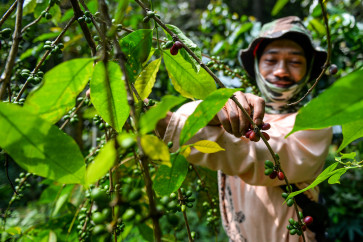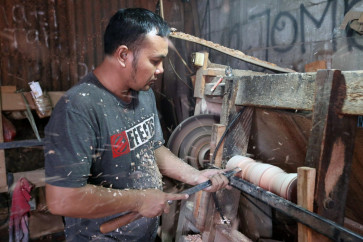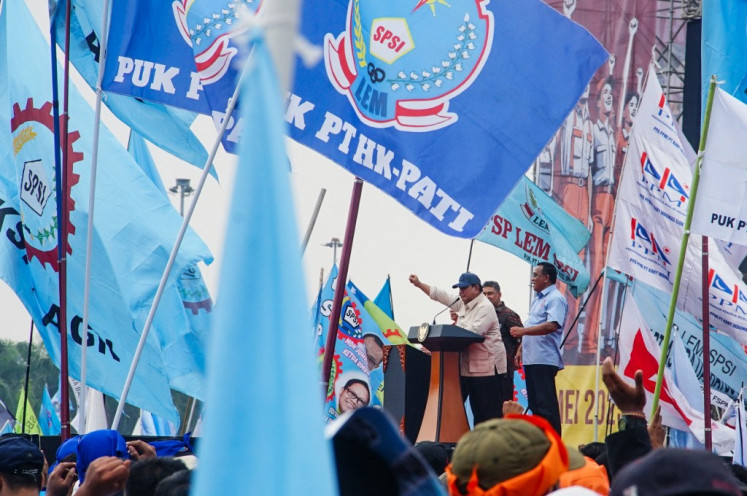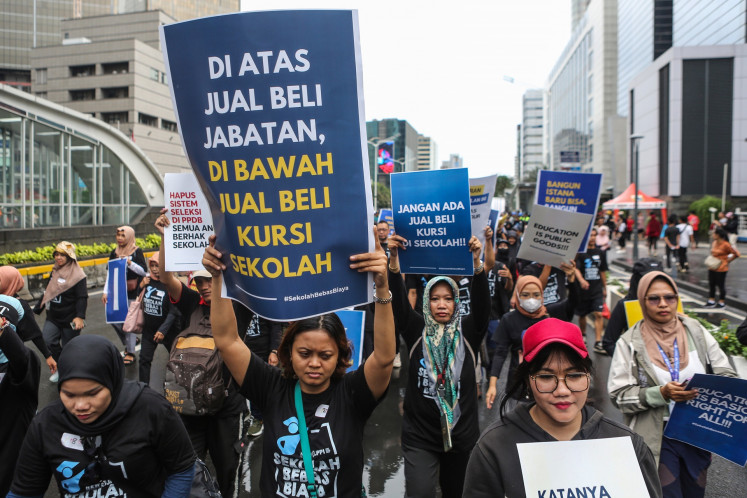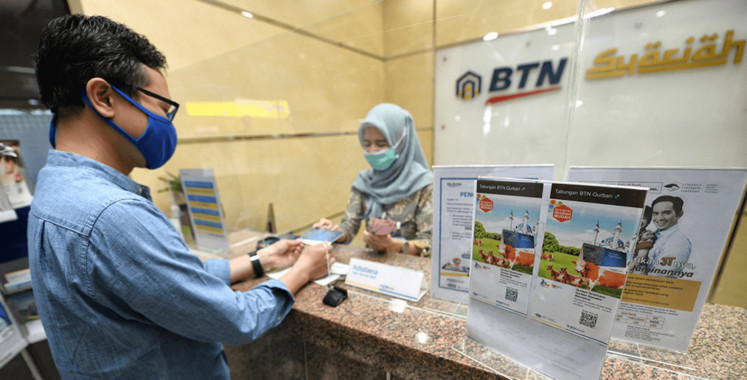Strong headwinds forecast for mining sector
As 2015 draws to a close, the Indonesian mining industry finds itself in the crosswinds of a global downturn in commodity prices, combined with domestic regulatory challenges that dampen investment sentiment among both local and international mining investors
Change text size
Gift Premium Articles
to Anyone

As 2015 draws to a close, the Indonesian mining industry finds itself in the crosswinds of a global downturn in commodity prices, combined with domestic regulatory challenges that dampen investment sentiment among both local and international mining investors.
Most analysts see downward pressure on commodity prices continuing for at least the short-term, which will make it difficult for Indonesia to attract significant investment for mining exploration or development in 2016.
At the same time, there is some hope for investment in the minerals sector, driven by the government's requirement to build in-country downstream processing for mineral ores. In the coal sector, development is being supported by the electrification push, with much of the ongoing 35GW expansion devoted to coal-fired power.
Nevertheless, 2016 will be a challenging time for the mining industry as it battles continuing strong headwinds.
Economic contribution
The mining sector has been one of the key sectors supporting Indonesia's economic growth for many decades. The sector makes a significant contribution to the country's gross domestic product (GDP), exports, government revenue, employment and, perhaps most importantly, the economic development of the remote regions where mining operations are located. However, mining's contribution to theeconomy has declined in recent years, as investment in new exploration has largely stagnated.
Based on Bank Indonesia data, the contribution of the mining sector to the country's GDP and total exports has declined from 5.9 percent and 16.6 percent, respectively in 2012 to 4.3 percent and 13.3 percent, respectively in 2015.
The mining sector has also attractedless foreign investment over this period, with the Investment Coordinating Board (BKPM)reporting that the contribution of the mining sector to the country's total foreign direct investment has plummeted from 17.5 percent in 2012 to only 4.2 percent in 2015.
In addition to the fall in global commodity prices, negative perceptions of the country's regulatory environment remain a key challenge to attracting investment inthe mining sector. Based on the Fraser Institute's latest survey released in February 2015, Indonesia's ranking was among the lowest (112 out of 122 countries analyzed) in terms of its policy potential index, which gauges how friendly government policy istoward the mining sector. The current low level of exploration spending also suggests that mining's contribution to the economy will not improve anytime soon. Based on data from the Metals Economics Group, Indonesia's share of the global exploration budget in 2014 was approximately2 percent, which is extraordinarily low compared to its mineral potential.
Mining companies both in Indonesia and globally have been forced to do business in a challenging operating environment since the onset of falling commodity prices in 2012, due to the slowdown in the economy globally, and particularly in China. The ban on exports of unprocessed minerals imposed by the government since January 2014 has further exacerbated this situation.
All of these factors have led to downturns in revenues, profitability and liquidity for most Indonesian mining companies, with the resultant impact on government revenues from taxes and royalties.This is evidenced by the reduced export revenues from coal, copper and nickel ' the three commodities which contribute the most to Indonesia's total exports ' over the last four years.
With the continuing lackluster performance as we approach the end of 2015, the general outlook for the mining sector in 2016 remains subdued.
Coal sector struggles
Indonesia is the world's largest exporter of thermal coal and coal is by far the largest contributor of export revenues from the country's mining sector. However, the coal sector has been particularly depressed in the last few years.
Coal mining companies have been hit hard by falling coal prices, with Indonesia's coal benchmark price for October 2015 of US$57.39 per ton, almost half the December 2011 price of $112.67 per ton.
During this prolonged period of low prices, coal-mining companies have been forced into cash preservation and cost-cutting measures in order to survive.
Coal-mining activities have historically been focused on the easy-to-mine coal deposits with lower stripping ratios, and high-calorific value, hence generating higher margins for miners. Many of these reserves are now heavily depleted, and given the low investment in exploration, the future costs of coal mining are expected to rise.
At current prices, it will be the large producers who are able to maintain production (albeit at lower margins) while some smaller, heavily indebted players will struggle to survive.
One saving grace in 2015 has been lower crude oil prices and a stronger US dollar, which are proving beneficial for Indonesian coal-mining companies by helping to lower operating costs. However, these benefits may not be sufficient in 2016 and beyond to offset the reduced margins from continuing pressure on coal prices. Many analysts forecast that the slump in coal prices will persist at least until 2020.
The World Bank, for example, has forecast that global coal prices will remain in the range of $50-$58 per ton for 2016-2020. With such negative short-term forecasts for coal prices, many junior and mid-size coal-mining companies are expected to struggle to maintain production levels in 2016, and may even face financial difficulties.
This is expected to lead to rationalisation and consolidation in the coal sector,with smaller mines with higher-value reserves being acquired by the larger players, and less profitable low-rank operations going out of business, particularly if they are highly leveraged.
This is not necessarily an entirely negative development, as the larger players generally have better environmental, safety and community-development practices, not to mention better compliance with tax and royalty regulations.
There is anecdotal evidence that lower coal prices (in conjunction with a number of government initiatives) have resulted in a reduction in the level of illegal exports from informal operators.
Recent developments in China, the world's largest consumer of coal, are also discouraging for the prospects of the coal sector. China has highlighted its desire to reduce coal consumption and shift to cleaner energy sources. With ongoing weakness in the Chinese real estate market, as well as an overall lower pace of urbanization and general economic growth, coal demand from China could weaken further.
Also, China has moved to protect its domestic coal industry by changing import tariffs and quotas, placing additional pressure on seaborne demand. Taking all of this into account, it is expected that coal demand from China in 2016 will remain flat at best. Indian demand has helped to some extent, with India surpassing China as the largest buyer of Indonesian coal since December 2014.
However, increases in Indian demand, while positive for Indonesia, are not expected to be sufficient to entirely offset the impact on global coal prices of the reduced appetite from China.

Power ' one bright spot for Indonesian coal?
On a more positive note, coal will play a much larger role in Indonesia's power sector going forward given that the existing electricity mix is not sustainable over the long-term. Even with the recent oil price collapse, oil-fired electricity generation is still much more expensive than coal-fired generation, particularly as Indonesia has been a net oil importer since the early 2000s. Indonesia is facing an electricity crisis with demand expected to increase by 8.7 percent per annumup to 2020.
The government has initiated a programme for an increase in generating capacity of 35GW to be built over the next five years, with 20GW to come from coal-fired generation.
As such, strong demand growth is expected from a domestic pipeline of coal-fired power plants, supported by regulations requiring miners to reserve a percentage of production for the domestic market. This is likely to lead to the coal industry becoming much more of an investment in the growth of the Indonesian economy, rather than an export-oriented industry.
Coal-mining companies may also continue to benefit to some extent from China's ban on imports of coal with high sulphur and high ash content. Australian coal mining companies have been hit hard by this policy in 2015, given their generally higher content of these impurities compared with Indonesian coal.

Uncertainties for mineral producers
Similar to coal, copper and nickel are also experiencing a dip in prices. According to the World Bank, the prices of copper and nickel declined approximately 35 percent and 48 percent respectively from January 2012 to September 2015.
In January 2014, the governmentimplemented a ban on the export of unprocessed minerals, as envisaged by the 2009 Mining Law, in order to stimulate smelter construction and increase the value of mineral exports.
Not long after the introduction of this regulation, nickel prices showed some uptick, given Indonesia's significant contribution to the global nickel ore trade; however, since the last quarter of 2014 up to now, nickel prices have declined in line with most other commodities on the back of the slowing global economy and demand from China.
On top of the price declines, Indonesia's mineral producers have also had to deal with the impact of the ban on exports of unprocessed minerals. While this may be an admirable policy in the long-term with its potential to support the growth of the economy, it comes at an unfortunate time, coinciding with
the global downturn in commodity prices, with the commensurate effect on profits and cash flows of miners, and hence their ability to fund development of downstream processing facilities.
The ban has had a significant impact on the nickel sector, where most production was not processed to the levels required by the regulations, and so there have been practically no exports of nickel ores in the two years since this regulation was introduced.
Exports of copper declined sharply in 2014, but picked up again in 2015 after Freeport Indonesia and Newmont Nusa Tenggara, the major producers of copper concentrate, came to an agreement with the government on their plans for smelter construction. Copper concentrate can be exported in semi-processed form but is subject to an additional export tax of 5 percent-7.5 percent depending on the progress of smelter construction.
The government is confident that the pipeline of nickel smelters coming online will see an increase in nickel exports in the near term.
Based on data from the Energy and Mineral Resources Ministry, there are currently 29 nickel smelters being constructed in Indonesia, 10 of those being more than 30 percent complete.
Indonesia's sought-after saprolite nickel ore has been a major draw card in encouraging foreign investment to support development of new nickel-smelting projects.
Investment hurdles
The mining industry was built on the back of the contract-of-work system introduced in the 1960s, whereby foreign investors entered into long-term contracts with the government for mining activities. Given the high cost, capital-intensive nature of mining, this system provided investors with the necessary certainty that they could generate a reasonable investment return over the life of the contract.
Many of these contracts are due to expire over the next five to 10 years, and without the certainty of a contract extension, high-cost expansions of production, or new exploration, will not be carried out unless a reasonable return can be made over the remaining life of the contract.
This is particularly the case in the current low-price environment. Until investors are clear on the terms for an extension, either as an extension to an existing contract or as a mining business permit (as contracts are no longer available under the 2009 Mining Law), there is unlikely to be significant new investment by many of the large mining companies in Indonesia ' particularly in the minerals sector, given the comparatively higher investment costs compared with coal mining.
This situation will continue to be a drag on growth in the industry in Indonesia in 2016 and beyond and should be an area of focus for the government, particularly during the current downturn in commodity prices, when investment budgets have already been slashed.
Outlook
It is difficult to be overly optimistic about growth in Indonesia's mining sector in 2016, due to the combination of an expected continuing low commodity price environment, combined with some of the local regulatory impacts specific to Indonesia.
However, as always, there are still bright spots for investors, particularly given the anticipated growth in the domestic coal sector to support the government's electrification targets, as well as opportunities for investment in downstream processing, particularly in the nickel space.
It will be important for investors and the government to work toward agreeing mutually beneficial outcomes for expiring contract areas as soon as possible, to avoid an even greater downturn in investment spending over the next few years.
_____________________________________
Sacha Winzenried is lead adviser and Dedy Lesmana is director of PwC Indonesia Energy, Utilities & Mining practice.


